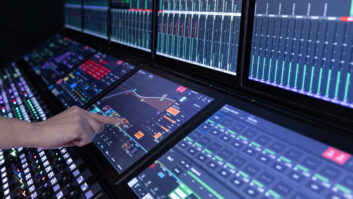By Dave Robinson
Santa Cruz, CA (November 2006)–Universal Audio has unveiled its Desktop Console System (DCS), a new concept and product line which initially includes the DCS Remote Preamp and DCS Monitor Master. The DCS modular family of products each combines a base unit with a DCS-Link-connected remote controller and can each be used individually or interconnected to form a multi-unit console. The first DCS product, the Remote Preamp, is scheduled to begin shipping in Q1 2007.
Key features of the DCS Monitor Master include a mixing/monitoring/recording “console master section”; 100 percent digitally controlled analog signal path via DCS-Link interconnect; five stereo inputs (three analog, two digital) and five stereo outputs; flexible talkback and reference-grade, 24-bit 192 kHz DAC.
DCS creator and ex-Euphonix founder, Scott Silfvast, talked with Pro Sound News Europe editor, Dave Robinson, about the DCS.
Scott Silfvast is pictured with Universal Audio’s Ear to the Ground Airstream trailer studio.”I started Euphonix with plenty of naiveté and optimism,” Silfvast says, “figuring that if the company never got off the ground, at least we would end up with a really cool mixing console for our studio. I designed most of the early analog console electronics, then my brother, Rob, came and helped me. He’s working with me now on the DCS system. He actually designed the first Euphonix EQ as a college project.”
It’s a classic plot for our age: Man starts company; man leaves industry; man returns to industry as hero. That’s Scott Silfvast, if you will. Comes to California, gets a job in hi-tech. Starts Euphonix because he wants more from his garage studio. Leaves Euphonix many years later to pursue musical interests. Wants more from his desktop studio now, so teams up with Universal Audio to produce DCS system that brings “Class-A console sound to the desktop.” But there’s so much more to it than that, of course. Take us back to 1988.
“I was 25 and had been working in Silicon Valley since 1983,” Silfvast recalls. “I had been into electronics and music since my early teens, playing around with preamps and effects for electric guitars and basses. I grew up on the East Coast, and as soon as I heard about the electronics boom in California, I moved out there. After a couple of months, I got a job as the third employee of a hi-tech startup called, Stanford Reseach Systems. I was a junior guy learning in leaps and bounds from the group of PhDs that built the company. They are still going strong today making scientific instruments for physics and chemistry labs.
“That was my day job. With some of my friends, we built a studio, and it turned out we wanted to record the way people record now, with tools that are instantly recallable. We were frustrated about the time it takes to change the reel and get a new mix up on the console. I knew I could build a mixing console that had a computer in it, it was totally automated, and it didn’t seem any more difficult to build than the equipment I was working on at my day job.”
So you started Euphonix…”I spent 13 years with that company, and we built some beautiful products; the System 5 digital console was my last project there.”
Did you have a hand in the CS2000 and 3000?
“There were many variations on the CS: the 2000, the 3000, we made broadcast desks, film desks, post desks. Then the company got big enough, and the market started changing. We had a great group of engineers, and everyone wanted to build a digital desk. So we started the System 5, which is one of the most amazing efforts I’ve seen from an engineering group.”
The CS3000 gained a reputation for its digital control of analog, which was something radical in itself. Silfvast remembers, “Harrison was making the Series 10 about that time, and there was the Trident Di-An, so there were others around, but we made it much more affordable. We really focused on the cost–being 25-year-old kids in a garage, we couldn’t imagine someone spending half a million dollars on a mixing console. We wanted our mixing consoles to cost £50,000. The timing was right because people like Hans Zimmer were starting to build project studios and not looking at buying an SSL but making their living by being productive and creating lots of work. You just couldn’t work that fast on an SSL with manual recall. It’s a combination of the technology and the price point that made the CS different.
“We took the company public in 1995, at a time before the dotcom boom, so we were a profitable public company! [Laughs] Fast forward to the late ’90s when the whole recording business is completely different. I’d been working for 13 years without a vacation. In the meantime, Yello’s Dieter Meier had become one of our great customers. When we were raising capital to develop the System 5, he came in as an investor, then took more of an interest in running the company, and now owns the company today. Martin Kloiber, who was Dieter’s sound engineer, is the CEO. The company’s in good hands.”
After that, you took a break…
“I spent a long time trying to improve the process of recording music, and I wanted to get back to making music, which used to be my top priority. I got back into project-studio mode, writing and recording. That’s kind of where these products came up. I stripped down my old studio, which had a bunch of rack gear and a couple of mixers, down to a computer and a keyboard and some guitars, and was trying to do everything in the computer.
“I was trying to find something that would replace the mixer. I thought, I’m used to cutting vocals with a reverb on it, but I don’t need an expensive Pro Tools DSP system to do that. So instead, buy a little reverb, patch that in; but all of a sudden you’ve got a rat’s nest of cables just to do a vocal take. So my brother and I took all that, combined it into a little box with a remote control, and that’s where the DCS came from.
“It was exactly like in the late ’80s–we had a problem, and we designed a solution for it. It was only when we started working with Universal Audio that we stood back and thought, my God, it looks like a miniature CS Euphonix!”
How did you hook up with UA?
“We had a basic design of the products, and we were looking for a partner,” Silfvast reveals. “Universal Audio was by far and away our ideal match. They are growing in their desktop market. They have these customers using the UAD-1, then they have these others buying high-end analog gear. Is there any way we can make something analog for the desktop people? We didn’t think price points of $2,000-$3,000 were right for these people. We wanted something that was under $1,000 but didn’t look, feel or sound cheap. I wanted a Taylor, a Gibson, you know? We want these to last for years and years. UA was looking to address that, too, so we decided to work together in the first meeting. We have a similar psychology.”
“Didn’t look cheap”–is that why you chose VU meters on the DCS design? “It’s for two things: the vibe–I like to turn off the computer so it feels like a studio, the warm glow of the VUs adding to the creative atmosphere. VUs also show the volume level in a way that peak meters can’t, so if you are cutting vocals, you can watch and manage your distance from the mic.”
Give me three key points of the two DCS products. “The DCS Remote Pre: A good quality 2-channel preamp at the price point; and adding reverb and EQ to your cue mix without printing; and getting all those cables off your desktop! I believe if the artist is inspired, they are going to record better. And with this, you can focus on getting a good take, without the clutter, instead of being an engineer.
“The Monitor Master solves the typical desktop studio monitoring problem. We had a design prototyped, then the Mackie Big Knob and the PreSonus CentralStation came out, so this is like the Universal Audio solution to that.
“The market has established monitor controllers as a new product category. We didn’t see that when we first designed it, though. We focused on the audio quality, and on tools that allow people to do mastering and mixing in a bedroom studio.
“And we put in a cue system with talkback; and the cool thing is, when you use the Remote Pre with the Monitor Master, there’s a little mic in each Remote which works together to give you talkback and listenback. That is just like working on an SSL or a Euphonix. So we say, get an Mbox, or similar audio interface, and add our system to your desktop, because that’s what we designed it for. We’re providing that upgrade path–that aspirational but accessible level.”
Universal Audio’s history is wrapped up in Bill Putnam Sr., Frank Sinatra’s engineer, while Euphonix’s history is now driven by Yello’s Dieter Meier. What’s your favorite album by the two artists?
Silfvast responds, “Sinatra: Songs for Young Lovers. Yello: Stella. The Sinatra album was recorded for Capitol Records, which I think was prior to the period he recorded at Bill Putnam’s studio; and the Yello album was recorded before Dieter and Martin Kloiber got their first Euphonix console. I wish I could say these records happen to connect serendipitously with Euphonix or Universal Audio, but they don’t.”
Universal Audio
www.uaudio.com







